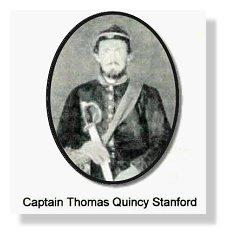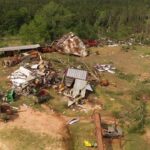
by
Steve Parrish
My visit to the battlefield at Murphreesboro, Tennessee several years ago means more to me now than I ever thought it would. A man that I never even knew existed was killed on the very ground I walked upon. His name was Thomas Q. Stanford. I would once again walk where he walked…this time, it was where he was buried.
I got off work one afternoon this past November and as usual, went home and upon arriving checked the answering machine for messages. There was a call from a man who taught at one of the local high schools who insisted I call him back.
His name was Brown. He said he found my telephone number off a web site where he discovered there was a Henry County chapter of the Sons of Confederate Veterans, of which I am the current Commander. He had nowhere else to turn and there was a pending crisis askew. Deep in the woods, way back in the county, all alone and unexplainable, laid the grave of a lone Confederate soldier that was in danger of being destroyed. A logging company was clear-cutting a forest and if they were not careful, would inadvertently destroy the grave of Captain Stanford. Another compatriot and I immediately went to survey the area.
This was what we in South Alabama we call this sort of place “in the sticks!” We drove down some winding roads and followed a crude map, which had been drawn by a nearby resident. We finally arrived. A local resident met us there and took us back into the woods to show us the site. If he had not been willing to do that, we would to this day, still be searching this vast woodland.

We located the grave and sure enough, “Captain Thomas Q. Stanford 39th Alabama Inf. Rgt. Co. G born June 22, 1831, wounded December 31, 1862 died January 1, 1863” was inscribed on the headstone. We contacted the logging company and made sure they knew about the grave. The job was finished! I’d done my duty as a Son of a Confederate Veteran…but then, I started thinking…what happened to Stanford?
My trip to the battlefield at Stones River was one of many Civil War sites I have visited in the past. It’s not Gettysburg or Antietam…no, in many ways it was much worse. It was a bloodletting that accomplished absolutely nothing except for the fact that it brought me to a dense forest to oversee the grave of a brave company commander who gave his thirty-one year old life at this bloody work.
Murphreesboro had two things in common with many other battle sites of the times. The Nashville to Chattanooga Railroad ran right through it. There was also a river there: The Stones River. Union General Rosecrans took his 47,000 man Army of the Cumberland and followed Bragg’s freshly defeated 37,000 Rebels south from Perryville en route to a winter encampment near the town. He was intent on attacking and defeating Bragg there. Rosecrans set up his headquarters alongside the railroad and not too far from the river.
Captain Thomas Stanford was in command of company “G” of the 39th Alabama Infantry Regiment when skirmishing opened on the 30th. Initially formed up in support of Robertson’s Florida artillery battery near the Widow Smith House, the 39th became first involved about 3:30 PM as three Federal infantry regiments led by the 21st Illinois advanced and attacked their position near the Triune Road. Their intent was to capture Robertson’s Florida artillery battery and wet their whistles with the sting of battle. Stanford and the rest of the 39th Alabama, along with two other regiments had other plans. The Rebs were willing and successful in stinging the Yanks, but they wanted to keep their artillery pieces. As darkness fell, the Federal assault was repulsed with heavy casualties on either side. The end for Thomas Stanford would come tomorrow.
On the morning of December 31st 1862, Confederate General Bragg ordered an attack. With the Yankees’ left flank guarded by the river; and a ford nearby to allow reinforcements from across river; they felt it could be protected. It would however, hinder an escape should it become necessary. Of this fact, Union General George Thomas would say to Rosecrans, “I know of no better place to die than right here”. With that resolve, the two armies were poised to collide at 6:30 that morning.
General Cheatham gave the order to attack the Federal left at daylight. The enemy was 300 yards in front of Loomis’ brigade as they vigorously advanced across the open area toward the “cedar woods”. Union lines buckled as the brigades slammed into their lines. They were driven back to a dense cedar forest. There, the Confederates found the enemy in superior numbers. Captain Thomas Stanford, in an effort to maintain organization in his company, was struck down – mortally wounded. He would die on New Year’s Day, 1863.
The Rebels were forced to retreat to their original lines as fighting erupted on in the Union center and right. The two armies collided in such areas known to the men as “The Slaughter Pen” and “Hells Half-Acre”. Appropriate names for the carnage they witnessed and participated in. The battle seesawed back and forth all day long as little was gained on either side. It had been General Rosecrans’ plan to go to Murphreesboro and attack and defeat the Army of Tennessee. He never ordered a single charge. He maintained a defensive posture the entire battle.
As darkness fell on New Year’s Eve, the fighting slowed to a halt. At a war council that evening Rosecrans was persuaded not to retreat. A strong General George Thomas-the man that would soon be dubbed, “the Rock of Chickamauga” for his gallant stand that would save the total route of the Union Army in November, assured Rosecrans they can hold.
Bragg lost a day on the first as he maneuvered a portion of his army across the Stones River to attack the Federal left flank until reinforcements arrived from crossing a ford in the River. Having been successfully repulsed on all fronts, Bragg began his retreat that evening.
Rosecrans, seeing his Army had been left with the field, telegraphed the Secretary of War the next morning and said, “God has crowned our army with victory.” Actually, his only victory was in that he had possession of the field. His army was pushed back at nearly all points on the battlefield and quickly plugged with reinforcements. He defended every hour of the battle and never pursued an advantage when one arose. His casualties were 12,000, killed, wounded and captured. Bragg fared little better, losing 10,200 men killed, wounded or captured. 1,200 of these captured were badly wounded soldiers left at the hospitals in Murphreesboro.
On must wonder what was going through the mind of Captain Thomas Q. Stanford between the hour he was wounded and the time he died? Was he shipped home on a train by a friend or perhaps a relative who fought at his side? Did he have a hunger to go home, or wonder if he would be buried in Tennessee? As the light in his eyes faded to gray, he must have known that he would never really know, he could only hope…
So as I stand in these woods now, just me and him, I have a newfound feeling about Thomas and the battle in which he fought and died. Like so many others who fought in this terrible War, the events of his past are similar to the circumstances that bring me to his grave…fate. May your name live on Thomas Q. Stanford and rest in peace. You’re remembered now but you were…almost forgotten.
[Steve Parrish is Command of the “Henry Light Infantry” Camp #1968, Sons of Confederate Veterans]



